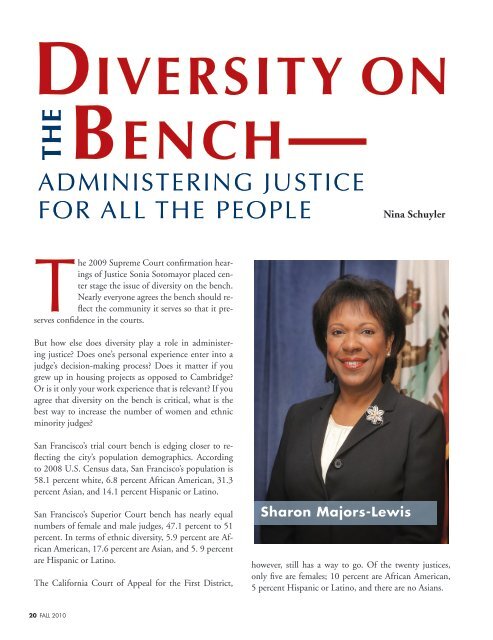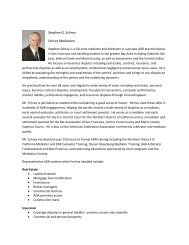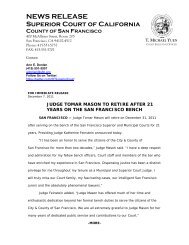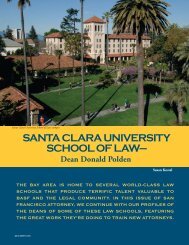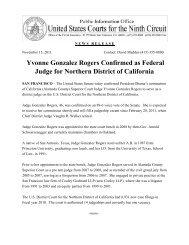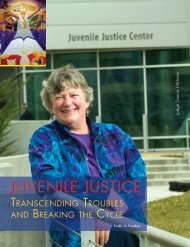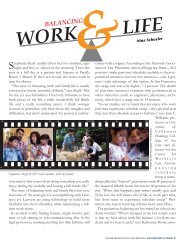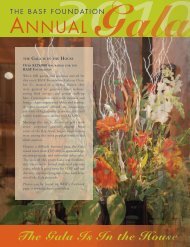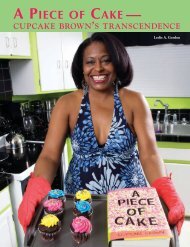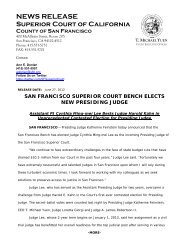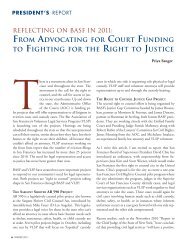BENCHâ - The Bar Association of San Francisco
BENCHâ - The Bar Association of San Francisco
BENCHâ - The Bar Association of San Francisco
You also want an ePaper? Increase the reach of your titles
YUMPU automatically turns print PDFs into web optimized ePapers that Google loves.
Diversity ontheBench—ADMINISTERING JUSTICEFOR ALL THE PEOPLENina Schuyler<strong>The</strong> 2009 Supreme Court confirmation hearings<strong>of</strong> Justice Sonia Sotomayor placed centerstage the issue <strong>of</strong> diversity on the bench.Nearly everyone agrees the bench should reflectthe community it serves so that it preservesconfidence in the courts.But how else does diversity play a role in administeringjustice? Does one’s personal experience enter into ajudge’s decision-making process? Does it matter if yougrew up in housing projects as opposed to Cambridge?Or is it only your work experience that is relevant? If youagree that diversity on the bench is critical, what is thebest way to increase the number <strong>of</strong> women and ethnicminority judges?<strong>San</strong> <strong>Francisco</strong>’s trial court bench is edging closer to reflectingthe city’s population demographics. Accordingto 2008 U.S. Census data, <strong>San</strong> <strong>Francisco</strong>’s population is58.1 percent white, 6.8 percent African American, 31.3percent Asian, and 14.1 percent Hispanic or Latino.<strong>San</strong> <strong>Francisco</strong>’s Superior Court bench has nearly equalnumbers <strong>of</strong> female and male judges, 47.1 percent to 51percent. In terms <strong>of</strong> ethnic diversity, 5.9 percent are AfricanAmerican, 17.6 percent are Asian, and 5. 9 percentare Hispanic or Latino.<strong>The</strong> California Court <strong>of</strong> Appeal for the First District,Sharon Majors-Lewishowever, still has a way to go. Of the twenty justices,only five are females; 10 percent are African American,5 percent Hispanic or Latino, and there are no Asians.20 FALL 2010
In California as a whole, as <strong>of</strong> December 31, 2009, womenrepresent 29.2 percent <strong>of</strong> the bench, according to theAdministrative Office <strong>of</strong> the Courts. Native Americansmake up .3 percent, Asians 5 percent, African Americans5.2 percent, and Hispanic or Latino 7.5 percent.According to Sharon Majors-Lewis, Governor ArnoldSchwarzenegger’s judicial appointments secretary, as <strong>of</strong>July 2010, 34.7 percent <strong>of</strong> appointees to the bench wereethnic minorities. “That’s more than double the 2005percentage, which was 15.5 percent,” she says. “I thinkwe’re doing something right.”her position since 2007 and is the first African Americanand first woman to serve as the judicial appointmentssecretary.<strong>The</strong> pipeline for a pool <strong>of</strong> ethnically diverse candidates istied to diversity <strong>of</strong> the bar as a whole. And that’s tied todiversity in law schools. At a minimum, a lawyer needsto have been a member <strong>of</strong> the California State <strong>Bar</strong> for tenyears and in good standing.“<strong>The</strong> most significant obstacle to diversity is thatmany ethnically diverse lawyers don’t botherapplying for a judgeship.”Sharon Majors-LewisPresident <strong>Bar</strong>ack Obama, too, is trying to increase diversityat the federal level. Since taking <strong>of</strong>fice, nearly half <strong>of</strong>the 73 candidates he has tapped for the bench have beenwomen. In all, 25 percent have been African Americans,10 percent Hispanics, and 11 percent Asian Americans.That means seven out <strong>of</strong> ten Obama court nominees arenontraditional, meaning they have not been white men.Yet few <strong>of</strong> these nominees have made it to the benchbecause <strong>of</strong> a deeply polarized confirmation process inthe Senate. During Obama’s first twenty-one months in<strong>of</strong>fice, his administration has been thwarted by unprecedenteddelays.Obstacles to Achieving a Diverse Bench<strong>The</strong>re are two ways to become a superior court judge:You can run for the position in a nonpartisan election fora six-year term. Or the governor can appoint you to filla vacant position on the court. To become an appellatecourt justice, you must apply and the governor nominatesyou.“<strong>The</strong> most significant obstacle to diversity is that manyethnically diverse lawyers don’t bother applying fora judgeship,” says Majors-Lewis, who has served in“<strong>The</strong>re’s also a more esoteric reason for the small pool <strong>of</strong>ethnically diverse candidates,” says Majors-Lewis. “<strong>The</strong>reis <strong>of</strong>tentimes a belief that what happened before will happenagain. If people felt they were marginalized and thesystem was stacked against them, they don’t want to putthemselves out there.”To counter that belief and increase the pool <strong>of</strong> candidates,Majors-Lewis spent most <strong>of</strong> 2007 traveling up and downthe state, speaking with groups and individuals about theprocess <strong>of</strong> becoming a judge. “I wanted to make the processas transparent as possible,” she says.Diversity, in her view, is not limited to ethnicity. “Wewant diversity regarding political party affiliation, sexualorientation, religious affiliation,” she says. “We wantbroad-based diversity.”Since Majors-Lewis’s appointment, ethnic and racial appointmentshave increased. For instance, prior to herarrival, nine African Americans were appointed to thebench from November 2003 to January 2007. After herappointment, twenty-eight African Americans were appointedfrom February 2007 to April 2010.Justice Maria Rivera, who sits on the First District, DivisionFour <strong>of</strong> the California Court <strong>of</strong> Appeals, and is thefirst Latina to serve on this court, says there are severalTHE BAR ASSOCIATION OF SAN FRANCISCO SAN FRANCISCO ATTORNEY 21
name should be submitted to the Judicial Nominee Evaluation(JNE) Commission. “When we looked at the issue<strong>of</strong> diversity, or the lack there<strong>of</strong>, we found the governor’sinformal groups that vet candidates are not very diverse,”says Harbin-Forte. “We need a paradigm shift in theway the applications are handled and how applicantsare evaluated.” Harbin-Forte’s JNE Commission has puttogether a checklist <strong>of</strong> practical suggestions to help someonecomplete the governor’s application form.To help increase the pool <strong>of</strong> applicants, Rivera is involvedwith two formal mentoring programs: the JudicialMentorship Program, launched by <strong>The</strong> <strong>Bar</strong> <strong>Association</strong><strong>of</strong> <strong>San</strong> <strong>Francisco</strong> this spring, and the Judicial MentorshipProject, with the Alameda County <strong>Bar</strong> <strong>Association</strong>.She also informally mentors University <strong>of</strong> <strong>San</strong> <strong>Francisco</strong>School <strong>of</strong> Law students who are interested in becominga judge.Maria RiveraDiversity and Its Effect on theJudicial CommunityWhile diversity provides the perception <strong>of</strong> fairness, it alsoinjects fairness into the substantive decision-making process,but not in a way you might think.obstacles. “<strong>The</strong>re’s a traditional bias in favor <strong>of</strong> appointingtrial attorneys with court experience,” says Rivera,who was appointed in 2002. “We need to expand thenotion <strong>of</strong> who will be a good judge to include areas <strong>of</strong> lawthat have traditionally been overlooked.”She also says the meaning <strong>of</strong> the “best” person for theposition must be reconsidered. “I always hear the argument,‘we only want the best,’” says Rivera. “But howdo you define best? If it’s always the smartest one in lawschool, from the best law school, the most prestigious lawfirm, the most experienced district attorney, you are pullingfrom a narrow subset <strong>of</strong> people. What if we expandour definition to include people who will be humble, empathetic,who will treat folks with dignity and respect?”Judge Brenda Harbin-Forte, Superior Court judge in AlamedaCounty and chair <strong>of</strong> the State <strong>Bar</strong> <strong>of</strong> CaliforniaCouncil on Access and Fairness’s Judicial Committee, saysthe entire process <strong>of</strong> appointing judges should be mademore transparent. <strong>The</strong> governor consults with privatescreening committees, <strong>of</strong> which the membership and theevaluation criteria used are not public. Yet these committeeshold a lot <strong>of</strong> power: they recommend whether yourBrenda Harbin-Forte22 FALL 2010
Trial court judges talk. To each other. In fact, they spenda lot <strong>of</strong> time together since the California Code <strong>of</strong> JudicialEthics requires judges to minimize the risk <strong>of</strong> conflictwith judicial obligations.Lillian SingGarrett Wong“What people don’t realize is that judges exchangethoughts and ideas,” says <strong>San</strong> <strong>Francisco</strong> Superior CourtJudge Garrett Wong, who was appointed in 2005 andcurrently presides over criminal trials at the Hall <strong>of</strong>Justice. “It’s very collegial. <strong>The</strong> other day, we met ourcolleagues from the civil court at a restaurant. A dozenor more <strong>of</strong> us sat and exchanged views on issues andtopics. I think diversity is important, especially for thiskind <strong>of</strong> exchange.”Judge Lillian Sing, who was elected to the MunicipalCourt in 1981, <strong>of</strong>ten has non-Chinese judges consultwith her about her background and culture. “<strong>The</strong>y mighthave a case involving Chinese litigants,” she says. “<strong>The</strong>yask questions so they are more sensitive to my culture.”This was not always the case, she says. “When I firststarted as a judge, there was no such forum. It was veryisolating and I <strong>of</strong>ten felt unwelcome.”In addition to informal exchanges, the <strong>San</strong> <strong>Francisco</strong>bench holds monthly meetings. <strong>The</strong> judges also serve onsubcommittees designed to improve the courts.“One <strong>of</strong> the wonderful things I’ve encountered is that anyone <strong>of</strong> my colleagues will get <strong>of</strong>f the bench if I have aquestion,” says Judge Monica Wiley, who was appointedby the governor in September 2009 and is the secondAfrican American female judge to sit on <strong>San</strong> <strong>Francisco</strong>’sSuperior Court bench. “I feel free to call anyone here.”At the California Court <strong>of</strong> Appeals for the First District,cooperation is built into the process <strong>of</strong> administering justice.Justices sit on panels <strong>of</strong> three. “We naturally collaborateon our decision making,” says Justice Rivera.<strong>The</strong> Role <strong>of</strong> Personal ExperienceDuring the confirmation hearings, Justice Sonia Sotomayor,who became the first Hispanic Supreme CourtTHE BAR ASSOCIATION OF SAN FRANCISCO SAN FRANCISCO ATTORNEY 23
experience in developing a rapport with jurors and litigants.“I was born and raised in the Bay Area,” she says.“I know the interests <strong>of</strong> the jurors. <strong>The</strong>y like the idea thathere is someone, a judge, who can remember when Stonestownhad an Emporium-Capwell. <strong>The</strong>y have a judge whounderstands and appreciates the community.”In Wiley’s opinion, it’s her work experience that is invaluable.“Prior to becoming a judge, I worked for ten years atthe city attorney’s <strong>of</strong>fice on the trial team and tried twenty-sevencases to verdict,” she says. She currently presidesover civil matters. “I think one prerequisite to this job ishaving an intimate knowledge <strong>of</strong> litigation and trying acase before a judge.”At the time <strong>of</strong> the writing <strong>of</strong> this article, thirty vacancieson the bench were waiting to be filled by the governor.“I’m 100 percent committed to diversifying the benchand finding the individuals who are the best and brightest,”says Majors-Lewis. “Each individual will be evaluatedbased on his or her uniqueness, skills, intelligence,and involvement with his or her community.”Harbin-Forte, whose life passion is increasing diversityon the bench, says there is still much work to be done.“It’s a huge issue for our state,” she says. “It’s about fairnessin the court system. Citizens have a right to comeinto court and receive justice without regard to gender orrace. We ought be able to present to them a judiciary thatreflects the population.”For <strong>San</strong> <strong>Francisco</strong> Superior Court Judge Ronald Albers,named to the post in 2009 as the first openly gay judgeto be appointed by Governor Arnold Schwarzenegger,personal experience plays a role in deepening a judge’sunderstanding. “In my mind, each judge regardless <strong>of</strong>background strives to determine the facts and apply themappropriately to laws <strong>of</strong> our country,” he says. “That’s ourjob, our sworn duty. And having said that, we all bringan array <strong>of</strong> personal experiences and perspectives. As I ammaking decisions, my personal experience enables me tounderstand issues that may be subtle or invisible.”“What diversity does is bring to the table rich and variedexperience,” says Wong. “If you grew up in the MissionDistrict, you have a different experience than someonewho grew up in Chinatown. That background is part <strong>of</strong>the makeup <strong>of</strong> a person, as is whether your prior legalwork has been in the civil arena or the criminal.”Ronald AlbersJustice Rivera says personal experience is critical. “If yougrew up in foster homes, imagine how much better you’llbe as a juvenile court judge.”<strong>The</strong> FutureNina Schuyler is a lawyer whose first novel, <strong>The</strong>Painting, was published in 2004. She can be reached atninaschuyler@hotmail.com.THE BAR ASSOCIATION OF SAN FRANCISCO SAN FRANCISCO ATTORNEY 25


